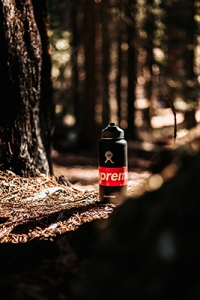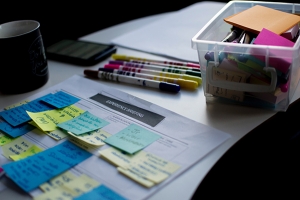3.3 Creativity enhancement techniques
 Creativity enhancement techniques
Creativity enhancement techniques
Can you imagine that a few people daydream about the same solution and they can co-operate with each other? How do you channel the creativity of a team in the same direction in order to accomplish a desired goal?
We will present you with some techniques which will support you in your mission to accelerate the creativity of people.
When thinking about the team we shall think about two or more individuals, interacting and interdependent, with who you are going to work with, in order to achieve a desired goal.
This group can be either formal or informal. Your employees or co-workers can create a formal group. When you meet with your friends and colleagues for coffee and talk about new ideas, this is an informal group.
 Creativity enhancement techniques can be very supportive in the following phases of frugal innovation process:
Creativity enhancement techniques can be very supportive in the following phases of frugal innovation process:
- Need
- Idea
- Project
- Decision
- Implementation
The need can mean a problem that you want to solve, or your determination to change something or your willingness to help others.
The examples of frugal innovations presented in the previous modules pointed out various needs:
- to help people in India store food in the area with no electricity,
- to redistribute a surplus food in order not to waste it,
- to provide access eye treatment to people who leave far away from eye clinics,
- to reduce waste collection costs,
- to support education in programming.
Some problems can be easily solved.
Examples of simple improvements of products
 Procter&Gamble developed a new toothpaste tube noticing the problem of old paste getting caked on the thread. “We’re going to save marriages with this product*” said the executive when he announced the idea of resigning from the screw threads entirely.
Procter&Gamble developed a new toothpaste tube noticing the problem of old paste getting caked on the thread. “We’re going to save marriages with this product*” said the executive when he announced the idea of resigning from the screw threads entirely.
But when they observed people who still had the habit of crew on and off instead of using the pop-off and pop-on caps, they decided to introduced the hybrid solution: combination of one-twist cap.
Interesting – look at your toothpaste tube. How does it open?
** FOOTNOTE** Kelly T., Littman J. (2001) Art of Innovation, Profile Books,
 The water bottle used by bike racers often gets covered with dirt of mud from the trail. It happens also with the nozzle, which shouldn’t be covered with any cap – racers need to have fast and easy access to drink while riding.
The water bottle used by bike racers often gets covered with dirt of mud from the trail. It happens also with the nozzle, which shouldn’t be covered with any cap – racers need to have fast and easy access to drink while riding.
The solution was found in nature. Humans heart has the tricuspid heart valve, which allows blood to flow only in one direction.
This was used in water bottles – when you squeeze it, the water can be easily drunk by racers. And dirt would not be let into the bottle.
Source: Kelly T., Littman J. (2001) Art of Innovation, Profile Books,
 Brainstorming helps to find the ideas.
Brainstorming helps to find the ideas.
Brainstorming is a technique which enables us to find a conclusion for specific problems by gathering a list of ideas spontaneously contributed by its members.
The most popular technique to generate creative ideas is brainstorming sessions.
Rules of successful brainstorming include:
• Abolishing criticism (participants are not allowed to express any judgement).
• The wilder idea the better (regardless how unrealistic an idea may seem)
• Quantity of ideas leads to quality (the more ideas the better)
• Mangers, CEOs, Presidents are not allowed in the room where brainstorming is conducted. (reduces any stress or judgement)
Useful guidelines:
- Warm-up and homework (come prepared)
- Define the problem properly
- Suspend judgement
- Cross-pollinate ideas
Did you know that…
Employees join teams because:
They feel secure by joining the group (they feel stronger)
They get strong sense of self-worth (self-esteem)
They can achieve more with the team
Robbins S. et al (1994) Organisational Behaviours. Sydney: Pretince Hall in Australia.
Advantages
- The generation of hundreds of ideas
- Support the organizational memory
- Impressing clients
- Improving morale
- Better understanding of each other
- Enjoyment
- Personal growth and well-being
- Think-up improvements
- Relatively inexpensive
Disadvantages
- The generation of ideas without screening them
- It may not be the answer to your problems
 Other techniques used in team working:
Other techniques used in team working:
Brainwriting: emphasize the silent generation of ideas, writing in contrary to talking session. Usually after a regular brainstorming session participants are requested to start writing down their ideas.
Two types of brainwriting can be distinguished:
Individual pool writing: Each participant writes ideas on a piece of paper and place it in the center of the table. Then each team member draws one of the sheets and adds more ideas.
Brain walking: ideas are written down on pieces of paper which are posted on the walls. Each participant walks around the room and adds their ideas in silent.
Nominal Group Technique: ideas are written down silently by each team member. Then ideas are presented and recorded e.g. on a whiteboard. Then the whole team discus all idea trying to prioritize them[1].
[1] Dawson P., Andriopoulos C., (2014) Managing Change, Creativity and Innovation, Saga Publications

